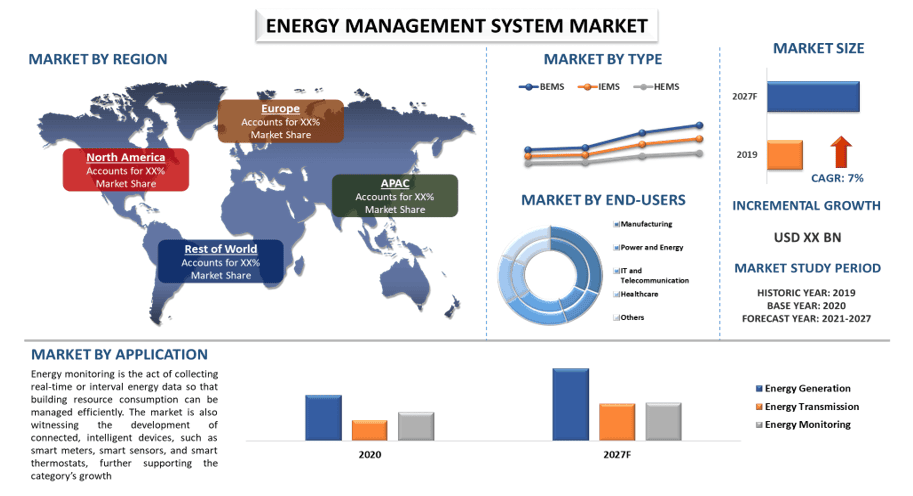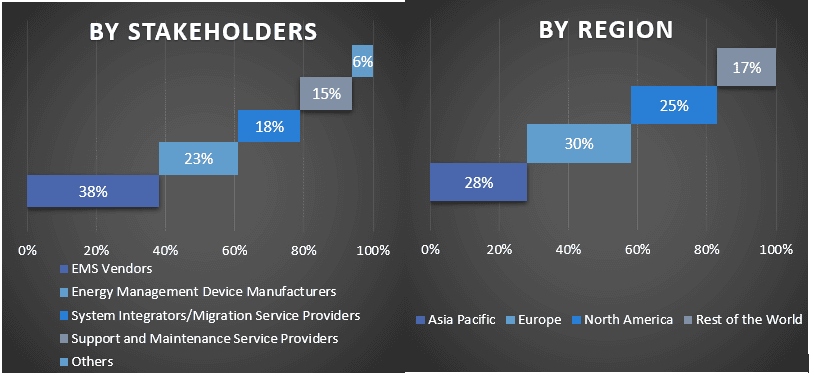
对电力传输和配电网络的投资增加,以及全球范围内传输和配电网络的增长和现代化,预计将推动市场发展。根据联合国工业发展组织 (UNIDO) 的说法,能源管理系统 (EMS) 是一个框架,供能源消费者(包括工业、商业和公共部门组织)管理其能源使用。它帮助企业识别采用和改进节能技术的机会,包括那些不需要大量资本投资的技术。在大多数情况下,成功的 EMS 实施需要专门的知识和员工培训。因此,随着能源消耗的增加以及强制性环境法规和政策在当前能源管理生态系统中的整合,预计全球 EMS 市场将在预测期内呈现指数级增长。
预计全球能源管理系统市场在预测期(2021-2027年)的复合年增长率约为 18%。能源管理是跟踪和优化能源消耗以节约使用的过程。EMS 的一些功能包括收集和分析连续数据、识别设备调度的优化、设置点和流速以提高能源效率、计算投资回报以及执行能源优化解决方案等。因此,由于对能源节约和管理的日益关注,预计 EMS 市场将在预测期内呈现指数级增长。此外,发展中国家电力消耗的激增正在加速智能电网的采用,加上升级现有基础设施的需求不断增长,对市场增长产生了积极影响。2021 年,中国的电力需求增长了 10%。这主要由水泥、建筑、钢铁和其他金属等工业部门推动。
IBM 公司、罗克韦尔自动化公司、通用电气公司、施耐德电气 SE、思科系统公司、Tendril Networks Inc.、伊顿公司、EnerNOC Inc.、Elster Group GMBH 和 SAP SE 是市场中的一些主要参与者。这些参与者已经进行了多项并购和合作,以向客户提供高科技和创新产品/技术。
报告中提供的见解
“在类型中,BEMS 类别将在市场中占据重要份额”
根据类型,市场分为 BEMS、IEMS 和 HEMS。其中,BEMS 预计到 2027 年将占据 значительная 的市场份额。这主要是由于对楼宇自动化系统需求的增加、全球对节能电气产品的需求增长以及城市人口和工业化活动的增加。此外,对电力传输和配电网络的投资增加,以及全球范围内传输和配电网络的增长和现代化,预计将推动市场发展。例如,2021 年 2 月,国家电网公司 (SGCC) 宣布将平均每年花费超过 700 亿美元(2021-2025 年),以升级电网至“能源互联网”并推动向清洁和低碳能源的过渡。
“在终端用户中,电力和能源类别在 2020 年占据 значительная 的市场份额”
根据终端用户,市场分为制造业、电力和能源、IT 和电信、医疗保健及其他。其中,电力和能源类别在 2020 年占据 значительная 的市场份额。这主要是由于公用事业公司在全球范围内日益采用和整合 EMS。例如,法国的一家区域电力公司 SICAE Somme & Cambraisis 集成了施耐德电气的 EcoStruxure ADMS 解决方案,用于其智能电网。该解决方案为他们提供了一个用于监督、优化电网管理、模拟、有效调度工程工作、事件管理和可追溯性的单一工具。此外,随着高层住宅和商业建筑的建设不断增加,预计市场将在预测期内呈现巨大的增长机会。例如,印度政府在 2014-15 年的联邦预算中宣布了一项项目,即通过现代化该国现有的中型城市,将“一百个智慧城市”发展为较大城市的卫星城镇,
“在应用中,能源监测类别预计将在全球能源管理系统市场中实现 значительная 增长”
根据应用,市场分为能源发电、能源传输和能源监测。在预测期内,由于互联、智能设备(如智能电表、智能传感器和智能恒温器)的开发增加,能源监测类别预计将在市场中实现 значительная 增长。此外,市场上的主要参与者正在关注各种策略,例如与当地公用事业公司合作并进入尚未开发的 и 发展中经济体。例如,2018 年,通用电气电力通过其电网解决方案与塔塔电力德里配电公司 (印度) 合作,推出了专为印度设计的新型高级配电管理解决方案 (ADMS),该解决方案具有监控、安全、分析和规划等高级功能,使塔塔电力-DDL 能够提高该州配电网络的可靠性、安全性和效率。
“亚太地区在预测期内将实现 значительная 增长”
预计亚太地区将在预测期内在能源管理系统市场中实现最高的复合年增长率。中国、印度和澳大利亚是该市场增长的主要贡献者。新兴经济体基础设施的增加,以及商业和工业部门的扩张,加上智能设备的安装和整合的增加,都促成了亚太市场的增长。此外,对旧电力传输和配电设备升级的投资不断增加,以及智能城市的不断发展,预计将支持市场的增长。此外,可再生能源发电项目的激增预计将对分流电抗器的市场需求产生积极影响。例如,2021 年,与 2015 年相比,中国的可再生能源总容量增加了 10.2 个百分点。根据国家能源局的数据,2021 年的装机容量超过 1,000 吉瓦,占全国总发电容量的 43.5%。
购买本报告的原因:
- 该研究包括经过权威行业专家验证的市场规模和预测分析。
- 该报告快速概览了整体行业表现。
- 该报告深入分析了主要的行业同行,主要关注关键的业务财务状况、产品组合、扩张战略和近期发展。
- 对行业中普遍存在的驱动因素、限制因素、主要趋势和机会进行详细检查。
- 该研究全面涵盖了不同细分市场。
- 对行业进行深入的区域级分析。
定制选项:
全球能源管理系统市场可根据要求或任何其他市场细分进行进一步定制。除此之外,UMI 了解您可能拥有自己的业务需求,因此请随时与我们联系以获取完全满足您要求的报告。
目录
分析历史市场、估算当前市场和预测全球能源管理系统市场的未来市场是创建和分析全球主要地区能源管理系统采用情况的三个主要步骤。进行了详尽的二手研究,以收集历史市场数据并估算当前的市场规模。其次,为了验证这些见解,考虑了大量的调查结果和假设。此外,还对全球能源管理系统市场价值链中的行业专家进行了详尽的一手采访。在通过一手采访对市场数据进行假设和验证后,我们采用自上而下/自下而上的方法来预测完整的市场规模。此后,采用市场细分和数据三角剖分方法来估算和分析行业细分市场和子细分市场的市场规模。详细方法如下:
历史市场规模分析
第 1 步:深入研究二手来源:
进行了详细的二手研究,通过公司内部来源(如年度报告和财务报表、业绩演示、新闻稿等)获取能源管理系统市场的历史市场规模,以及包括期刊、新闻和文章、政府出版物、竞争对手出版物、行业报告、第三方数据库和其他可靠出版物在内的外部来源。
第 2 步:市场细分:
在获得能源管理系统市场的历史市场规模后,我们进行了详细的二手分析,以收集不同细分市场和子细分市场的历史市场见解和份额。主要细分市场包括报告中按类型、终端用户和应用。进一步进行了国家级分析,以评估在该地区测试模型的总体采用情况。
第 3 步:因素分析:
在获得不同细分市场和子细分市场的历史市场规模后,我们进行了详细的因素分析以估算能源管理系统市场的当前市场规模。此外,我们使用各种类型、终端用户和能源管理系统设备的应用等因变量和自变量进行了因素分析。考虑到全球范围内能源管理系统市场领域的顶级合作伙伴关系、并购、业务扩张和产品发布,对供需情况进行了彻底分析。
当前市场规模估算和预测
当前市场规模确定:根据上述 3 个步骤中的可行见解,我们得出了当前的市场规模、全球能源管理系统市场的主要参与者以及各细分市场的市场份额。所有必需的份额拆分和市场细分均使用上述二手方法确定,并通过一手采访进行了验证。
估算和预测:对于市场估算和预测,为不同的因素(包括驱动因素和趋势、限制因素以及利益相关者可用的机会)分配了权重。在分析了这些因素后,应用了相关的预测技术,即自上而下/自下而上的方法,以得出有关 2027 年全球主要市场不同细分市场和子细分市场的市场预测。用于估算市场规模的研究方法包括:
- 该行业的市场规模(以收入(美元)计算)以及能源管理系统市场在全球主要市场的采用率
- 所有市场细分和子细分的百分比份额、拆分和细分
- 全球能源管理系统市场主要参与者,按提供的解决方案划分。此外,这些参与者为在快速增长的市场中竞争而采取的增长战略
市场规模和份额验证
主要研究:与主要地区的关键意见领袖 (KOL) 进行了深入访谈,包括高层管理人员 (CXO/VP、销售主管、市场营销主管、运营主管和区域主管、国家主管等)。然后总结主要研究结果,并进行统计分析以证明所陈述的假设。将主要研究的输入与次要研究结果相结合,从而将信息转化为可操作的见解。
不同地区主要参与者的拆分

市场工程
采用数据三角测量技术来完成整体市场估算,并得出全球能源管理系统市场各细分市场和子细分市场的精确统计数据。在研究了全球能源管理系统市场中类型、最终用户和应用领域中的各种参数和趋势后,将数据拆分为几个细分市场和子细分市场。
全球能源管理系统市场研究的主要目标
研究确定了全球能源管理系统市场的当前和未来市场趋势。投资者可以从研究中进行的定性和定量分析中获得战略见解,从而为其投资决策提供依据。当前和未来的市场趋势决定了区域层面上市场的整体吸引力,为行业参与者提供了一个平台,以利用未开发的市场,从而获得先动优势。研究的其他定量目标包括:
- 按价值(美元)分析能源管理系统市场的当前和预测市场规模。同时,分析不同细分市场和子细分市场的当前和预测市场规模
- 研究中的细分市场包括类型、最终用户和应用领域。
- 定义和分析能源管理系统市场行业的监管框架。
- 分析涉及各种中介机构的价值链,同时分析行业的客户和竞争对手行为。
- 分析主要地区能源管理系统市场的当前和预测市场规模。
- 报告中研究的主要地区包括亚太地区、欧洲、北美洲和世界其他地区。
- 能源管理系统市场的公司概况以及市场参与者为在快速增长的市场中保持生存而采取的增长策略
- 行业深度区域级分析
相关 报告
购买此商品的客户也购买了










